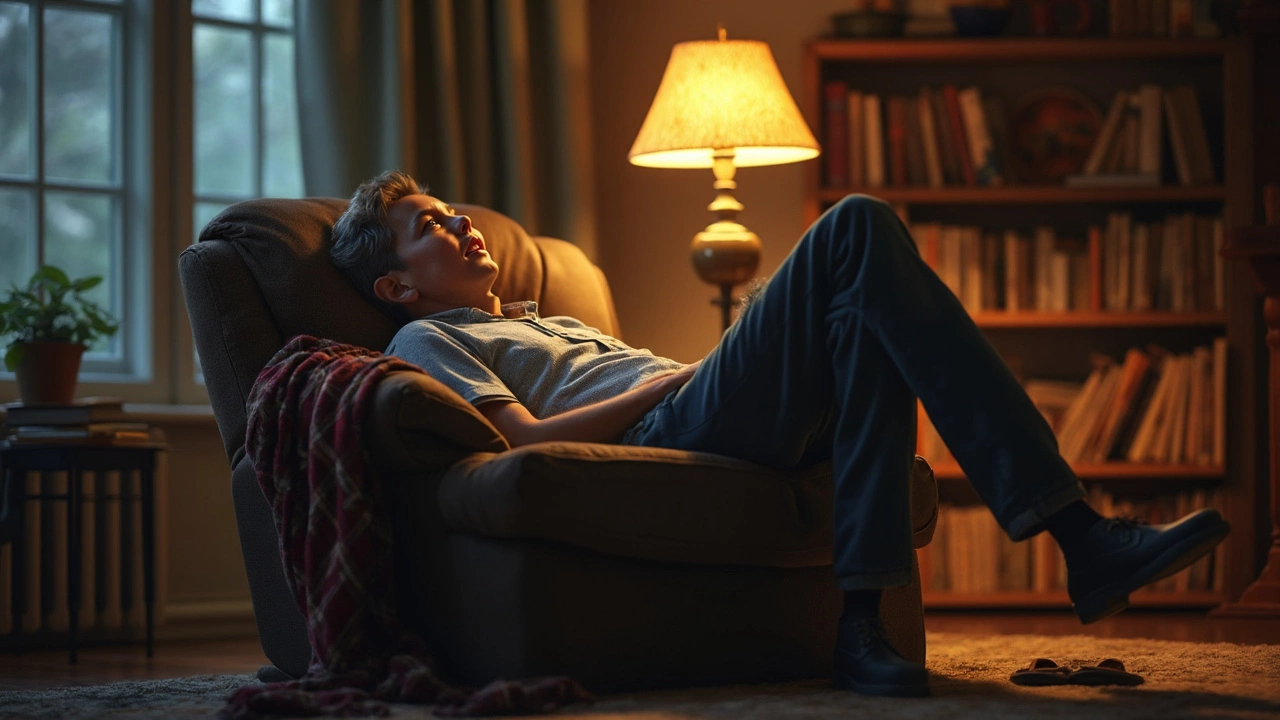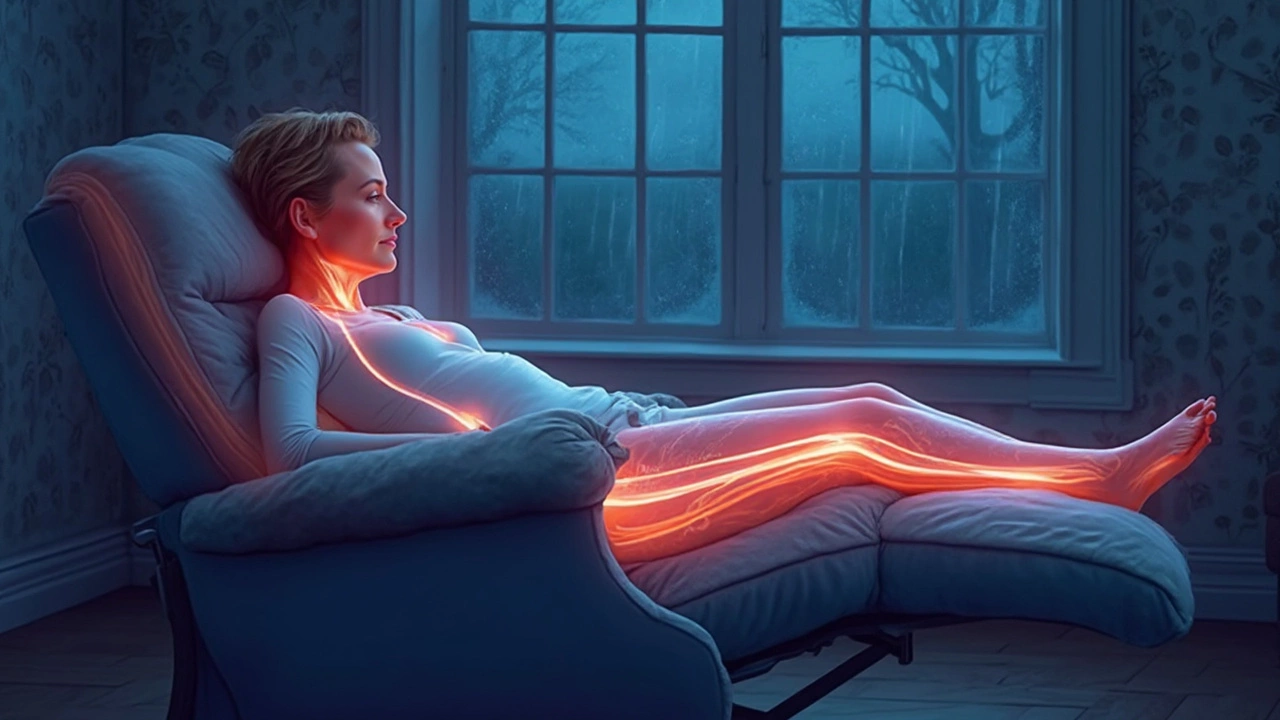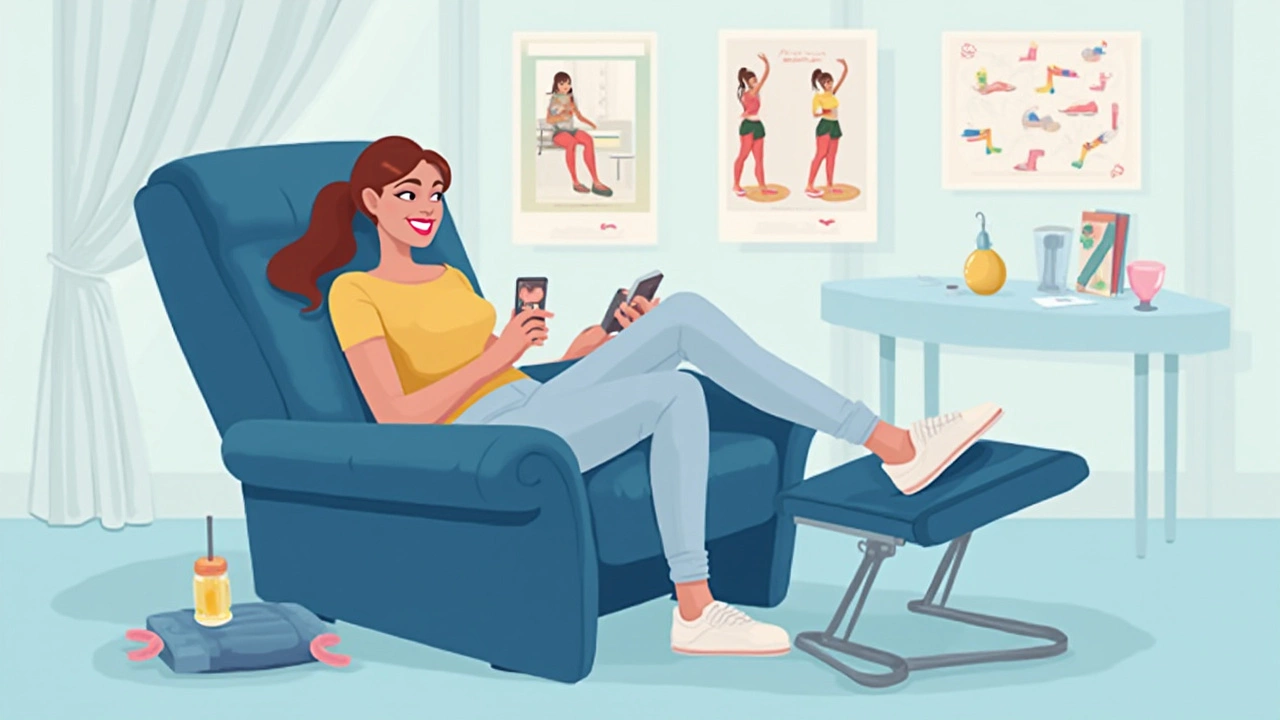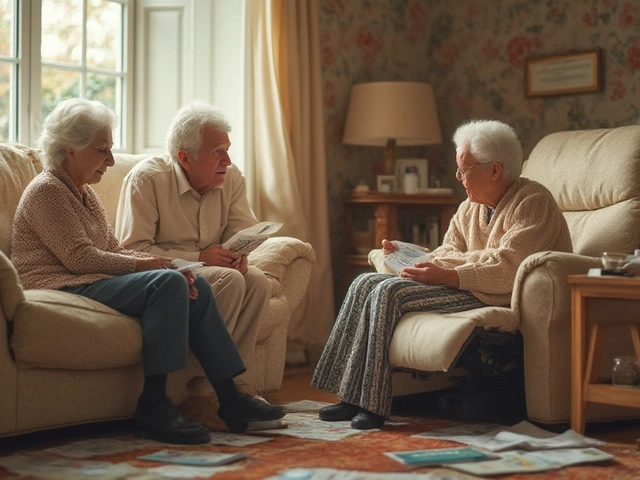 18
Apr,2025
18
Apr,2025
Your recliner is basically calling your name after a long day. It’s comfortable, it supports your back, and sometimes—let’s be honest—you just fall asleep in it. But should you actually sleep there overnight, especially if you care about your legs?
It’s not only about comfort. The way you position your legs in a recliner matters. If you keep your feet above your heart, you might get less swelling, which is pretty helpful if you stand a lot during the day. But if your knees are bent for hours, blood flow can slow down, and that’s where leg problems might sneak in.
If you wake up with tingling, numbness, or swollen calves, it’s your body trying to tell you something. Circulation plays a big role here. In a perfectly adjusted recliner, your legs should feel relaxed, not squished or dangling. Any weird pressure over time can make things worse, especially if you have circulation issues already.
- Why People Sleep in Recliners
- How Recliners Affect Leg Circulation
- Common Leg Problems from Recliner Sleeping
- Spotting Trouble: Warning Signs
- Tips for Safe Recliner Napping
Why People Sleep in Recliners
If you’ve ever dozed off with the TV on or nursed a sore back, you know the pull of a recliner chair. For a lot of folks, it’s not just being lazy—sometimes sleeping there feels like a real lifesaver. Let’s talk about why so many people swap their beds for the living room chair.
First up: comfort. Recliners let you raise your legs and support your back at the same time. This can actually help if you have acid reflux, sleep apnea, or chronic back pain. My friend who had rotator cuff surgery basically lived in his recliner chair for weeks, because lying flat felt like torture.
Another big reason? Swelling and circulation. If you work long hours on your feet, putting your legs up in a recliner feels amazing. Plus, pregnant women, people with heart issues, and seniors sometimes find they sleep better with their upper body slightly raised.
If you don’t sleep well in a regular bed—maybe because of arthritis or tossing and turning—a recliner gives you more options to prop up your legs or shift your posture. It’s no wonder furniture stores actually market certain chairs as “sleepers” for those with medical needs.
| Reason | Who Benefits |
|---|---|
| Back pain relief | Chronic pain sufferers, post-surgery patients |
| Reduces heartburn | Acid reflux, GERD |
| Better breathing | Sleep apnea, snorers |
| Swelling control | Pregnancy, varicose veins, desk workers |
No one’s saying recliners outdo beds in every way. But for some, a recliner chair isn’t just a backup—it’s the only place they can actually sleep through the night.
How Recliners Affect Leg Circulation
When you sleep in a recliner chair, your legs don’t always land in the same position as when you’re in bed. And honestly, your circulation can get a bit weird depending on how much you recline and where your feet rest. Let’s break down what actually happens to your legs.
If you can prop your legs up so they’re higher than your heart, your body gets a little help pushing blood and fluids back up—less chance for swollen feet or ankles. But if your legs are hanging off the edge, or the chair puts pressure behind your knees, blood flow can slow down. That’s when you might wake up with pins and needles, or even swelling that hangs around after you stand up.
Pressure points make a difference, too. Most recliner chairs are padded, but if your chair is stiff or the footrest pushes right up under your calves, it can press on veins and make it harder for blood to get moving. This matters even more for people with diabetes or varicose veins. Sometimes, older folks (like my own dad) get cold or numb toes if circulation isn’t great—recliners can make that worse if the fit isn’t right.
Here's a quick look at what matters in your reclined position:
- Angle of Recline: More tilt can help blood flow if feet are up, but don’t overdo it—knees bent too tightly aren’t ideal either.
- Foot Placement: Feet higher than your heart? That’s good. Dangling feet or knees jammed? Not so much.
- Duration: The longer you stay put, the more chance for trouble. Your body likes a change in position every so often.
If you like numbers, check this out:
| Leg Position | Effect on Blood Flow |
|---|---|
| Feet above heart | Improved return to heart, less swelling |
| Knees bent over 90° | Blood flow slows, can cause numbness |
| Feet hanging down | Blood pools, swelling risk goes up |
You don’t have to panic if you’re a fan of snoozing in your recliner chair. But checking in with your body—especially your legs—makes a difference. If you notice marks on your calves or tingling toes, it’s time to adjust your setup, maybe with a pillow under your calves or a quick stretch before standing up fully.

Common Leg Problems from Recliner Sleeping
Sleeping in a recliner chair isn’t exactly a crime, but your legs can pay the price. Some folks wake up just fine, while others start to notice weird leg issues over time. Here’s what you might run into if you make a habit out of catching Z’s in your favorite chair.
Poor circulation is easily the biggest one. When your knees stay bent for hours, blood flow from your legs back to your heart slows down. It’s the same reason sitting for long car rides is risky. Stiffness and swelling—especially around your ankles and calves—are signs that blood isn’t moving like it should.
On top of that, there’s the risk of deep vein thrombosis (DVT), which is a blood clot forming in a deep leg vein. Now, this isn’t super common if you’re healthy, but older people or folks with certain health issues (like poor circulation or a history of clots) have a much bigger risk. The danger gets worse if your legs are stuck in a cramped or awkward position all night.
Numbness and tingling are other familiar complaints. If the chair presses weirdly against the backs of your knees or calves, you’re basically blocking nerves. Sometimes it’s mild, other times it’s "wake-up-and-shake-your-leg" annoying. If it’s happening often, your recliner setup needs a rethink.
Let’s not forget muscle stiffness. Sleeping in a recliner chair keeps your legs semi-bent. This can make muscles around your knees and hips tight. And if you slouch or slide down overnight, even the backs of your thighs can hurt by morning.
For people with chronic leg swelling (like from varicose veins or heart issues), sleeping with legs slightly elevated can help. But the position needs to be just right: feet higher than the heart, no sharp bends at the knees, and good support under the calves.
| Common Problem | Possible Cause | Clue You’ll Notice |
|---|---|---|
| Circulation Issues | Bent knees, compressed vessels | Swelling, cold feet, numbness |
| Deep Vein Thrombosis | Staying still, poor blood flow | Redness, pain, swelling |
| Stiff Muscles | Bent legs, awkward posture | Pain, tightness, limited motion |
So if you love your recliner chair, pay attention to these red flags. Your legs shouldn’t ache in the morning. If they do, tweak your sleeping position, adjust the footrest, or take breaks for stretching.
Spotting Trouble: Warning Signs
If you like nodding off in your recliner chairs, you’ve got to watch out for certain signals from your legs. These aren’t just random aches—they’re your body’s way of flagging problems. Ignoring them can actually put your leg health at risk.
Here’s what screams red flag when you’re sleeping in a recliner too much or in an awkward position:
- Tingling or numbness: If you wake up and your feet or lower legs are asleep or buzzing, that means nerves or blood vessels are getting squished or blocked somewhere.
- Swelling (edema): Legs or feet getting puffy, especially by morning? That’s usually a sign that blood is pooling, not circulating right.
- Cramping: Sudden, sharp calf cramps in the middle of the night are a common hint that your legs aren’t getting enough movement or flow.
- Discoloration or coolness: If your skin turns pale, blue, or your feet feel colder than the rest of you, that’s not good—your blood flow’s probably not up to par.
- Persistent soreness or heaviness: Feeling like you’re dragging your legs the day after? That could be a warning sign, especially if it keeps happening.
To drive it home, here are some actual numbers that show how common these issues can get if you sit too long without adjusting. Experts from a 2023 review in the "Journal of Leg Circulation" found:
| Symptom | % of recliner sleepers with symptom |
|---|---|
| Leg swelling | 22% |
| Calf cramps | 17% |
| Tingling & Numbness | 28% |
If you notice any of these warning signs, don’t just shrug them off. Adjust how you’re using the recliner, and if things don't improve, it’s smart to chat with your doctor, especially if you already have leg health concerns or circulation issues.

Tips for Safe Recliner Napping
If you love crashing in your recliner chair, a few tweaks can make it way safer for your leg health. You don’t have to give up the comfort, but you can dodge a lot of the bad stuff that can happen during a long nap.
- Adjust your angle. Go for a recline that puts your legs slightly above your heart. This position helps your blood flow and cuts down on swelling. Most experts recommend an angle of about 135 degrees for sleeping—not totally flat, and not sitting upright like in a movie theater.
- Keep your legs straight but supported. Don’t let your legs dangle or bend for hours. If your recliner stops short, add a rolled-up towel under your knees or ankles for extra support. Your legs shouldn’t feel squeezed or heavy.
- Change positions now and then. Even if you zone out, wake up and shift every couple of hours. Wiggle your toes and stretch out—think of it as a quick reboot for your muscles and circulation.
- Watch out for foot swelling or numbness. If your calves or feet swell every time you nap, it could be a sign of poor leg circulation. Take breaks or try a different sleeping setup if this keeps happening.
- Dress for comfort and safety. Skip tight socks or pajama bottoms that bunch up. Loose-fitting clothes make a huge difference for your circulation. Also, keep a blanket handy but light, so you don’t overheat or trap your legs.
- Drink water. Staying hydrated helps your muscles and keeps blood from getting sticky and sluggish, which sometimes leads to muscle cramps or even increased risk of clots.
- Check your recliner’s design. Some recliner chairs are just better for sleeping. If you nap often, pick a model with enough leg and lumbar support. Look for smooth edges—no sharp or hard bars under your thighs.
Here’s a quick look at what makes a snooze in a recliner chair healthier for your legs:
| Feature | Why It Matters |
|---|---|
| Leg elevation above heart | Improves blood flow, reduces swelling |
| Change positions | Prevents numbness and pressure sores |
| Support under knees/ankles | Reduces stress on joints and ligaments |
| Loose clothing | Keeps blood moving, lowers risk of restricted flow |
If you start to notice ongoing issues—like swelling or pain that won’t quit—it’s worth talking to a doctor, especially if you’ve got other circulation problems. But for most people, sleeping in a recliner chair comes down to being smart about your posture and listening to your body.




